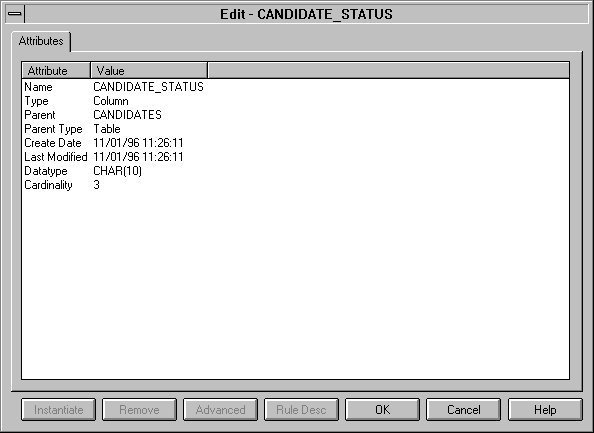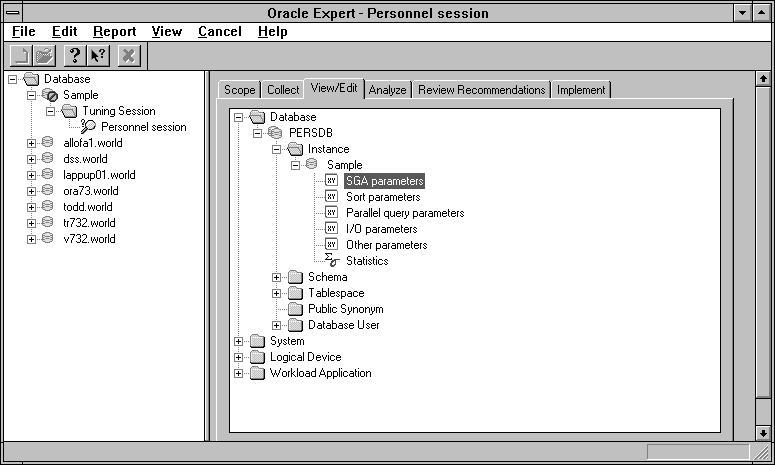| Oracle Enterprise Manager Oracle Expert User's Guide | Library |
Product |
Contents |
Index |
| Oracle Enterprise Manager Oracle Expert User's Guide | Library |
Product |
Contents |
Index |
When you use the View/Edit Page in conjunction with the Edit Pull-Down Menu, Oracle Expert gives you the ability to view, edit, add to, and delete from the data that you collect. Also, you can view and edit the rules and attributes associated with the data on the View/Edit page of the tuning session window. The hierarchical data on the View/Edit page consists of:
Use the Edit pull-down menu in conjunction with the View/Edit page. Highlight the desired object on the View/Edit page (see Figure 6-4), then select the desired option on the Edit menu.
As an alternative, you can also use the right-most mouse button to add, modify, delete, validate, and export objects.
Add
When you select a folder (see Figure 6-1), the Add option allows you to include objects you did not previously consider for tuning. However, be aware that objects that you add on this screen do not have collected data associated with them. You must add the required data manually.
Figure 6-1: Instance Folder
Some objects cannot be added. If you select a folder and the Add option is not available on the Edit menu, objects of this type cannot be added manually. These objects must be collected by Oracle Expert. Most schema objects cannot be added by the user.
Modify
The Modify option allows you to change the attributes and rules of a particular object. For example, for the Candidate_Status column, the Attributes page provides the Parent (Candidates) and Parent Type (Table) of the column (see Figure 6-2).
Figure 6-2: Attributes for the Candidate_Status Column

Changing Values
When you modify attribute and rule values, you will notice the different ways to change the values. When you click on the value, you will see one of the following:
After you instantiate a rule, the letter R appears on the icon for the object on the View/Edit page, which indicates that a rule has been instantiated for the object.
Figure 6-3: Rules for SGA Parameters
But what happens if you change a rule? Does the change affect the child objects in the hierarchy? When you instantiate a rule for an object, the object's children that do not instantiate the rule are affected. For example, let's analyze the "Maximum number of index segments" rule for schemas and tables. You can change that rule to be different for a schema and table. (The schema is the parent of the table and the table is the child of the schema.)
|
Object
|
Maximum Number of Index Segments
|
|---|---|
|
Database
|
15
|
|
10
| |
|
6
| |
|
13
| |
|
10
| |
|
15
|
The user who instantiates a rule can also change the value of a rule.
Delete
The Delete option allows you to eliminate objects from the collected data for the tuning session. When you delete an object, you are deleting all its children. Also, if you delete an object that one or more other objects refer to, you invalidate the other objects. For example, if SQL statements in your workload reference a schema and you delete that schema object from Oracle Expert, the workload becomes invalid. Validate
The Validate option allows you to validate schema and workload objects. For example, you would use this option if you imported a workload but not its associated schema. Once you import the schema, you can validate the workload against that schema. You can also validate a schema against other schemas and public synonyms, where external references exist.
To export an entire tuning session, select the tuning session and choose File=>Export.
The Export option is intended for Oracle Expert use only. Use this option if you want to use this data in another tuning session (for collection purposes). For example, if you want to export system data, click on System on the View/Edit page, choose Edit=>Export and supply the name of the .XDL file you want to create. This will copy disk and system information of the current tuning session to the .XDL file.
Oracle Expert default rules give you control over the adjustable parameters that affect the rules. The default values for these rules are intended to represent reasonable average settings for a database environment. If one or more of the settings do not adequately represent your database environment, Oracle Expert provides you with the ability to change the settings.
You can change the default values of the default rules Oracle Expert allows you to view. For example, by default, Oracle Expert recommends a maximum of 10 sorted indexes per table. If you want Oracle Expert to recommend a maximum of 3 sorted indexes per table, you can change the default value of the default Table rule "Maximum sorted indexes per table" from 10 to 3. (Select Edit=>Default Rules, choose Table for the Rule/Object Type in the Edit - Rules Default Settings dialog box.)
Changes to the default rules apply to every tuning session in Oracle Expert within that particular repository. Be aware that once you change the default value of a default rule, there is no automatic reset back to the rule's original value when you installed Oracle Expert. However, you can manually change the default back to the original value.
Click on the plus (+) sign to see the children of an object.
Figure 6-4: View/Edit Page

Databases
For the database object, you can view and edit associated attributes and rules. To view and edit these rules and attributes, place your cursor on the name of the database, choose the Edit=>Modify menu option, and choose either the Attributes tab or the Rules tab. Attributes include Total Datafiles and Degree of Parallelism. Rules include the Common rules, and rules for Database, Schema, Table, Schema Analysis, Index Analysis, and Tablespace. Instances
Under the instance object, you can change instance rules and attributes, and statistics attributes.
Within Oracle Expert, you can edit data for all the schemas you can access in your database. The objects within a schema that you can edit are: tables (including columns, indexes, and constraints), clusters, and synonyms.
If a schema object is missing or incomplete for a tuning session that expects schema data, Oracle Expert will not attempt to make recommendations on objects related to the missing schema object.
The accuracy of the necessary data is very important. When Oracle Expert attempts to form tuning strategies, it assumes that the input data is accurate. If that is not the case, the quality of the recommendations may be unreliable. For example, cardinality is a critical attribute in both tables and columns. Oracle Expert relies heavily on the cardinality values to predict sizing and index formation. If the cardinality values are incorrect or missing, Oracle Expert may recommend very poor index structures or no index structures at all.
Oracle Expert uses the View information to track SQL text backwards to the appropriate base table. If no workload exists, Oracle Expert can use views to form access methods strategies based on SQL text.
Frequency is the number of times a request, transaction, or business unit is repeated when a specific transaction, business unit, or application (respectively) is executed.
Note that frequency and importance affect the recommendations given by Oracle Expert.
|
Prev Next |
Copyright © 1996 Oracle Corporation. All Rights Reserved. |
Library |
Product |
Contents |
Index |